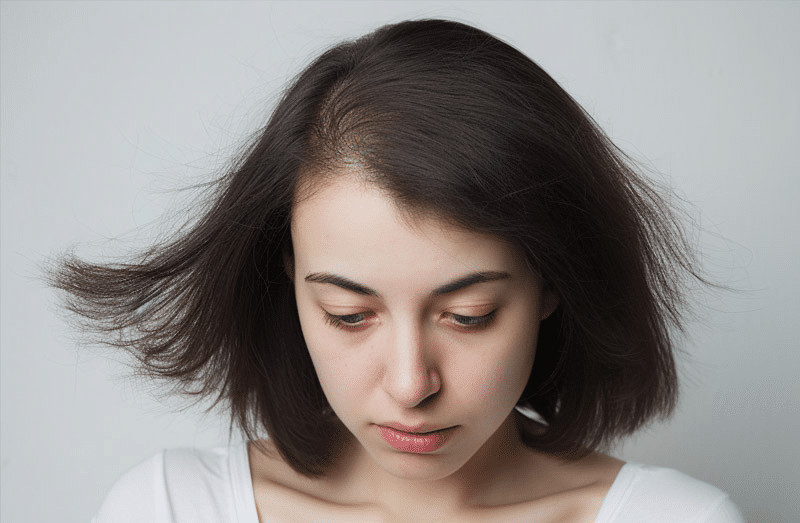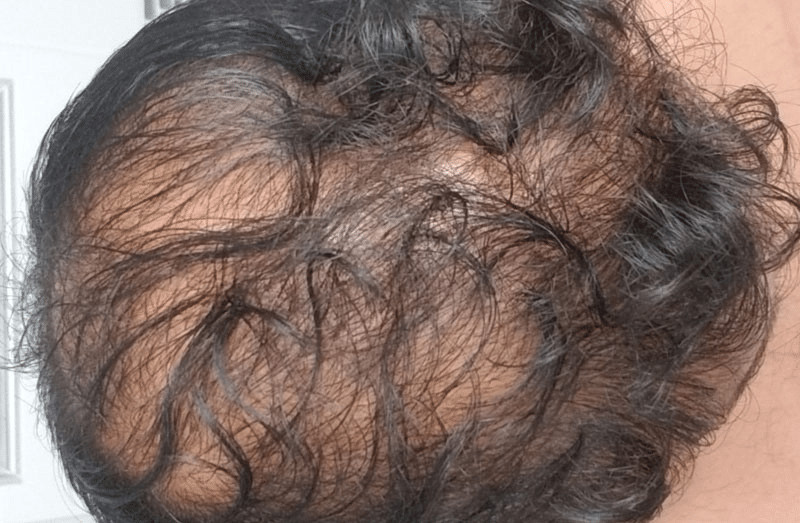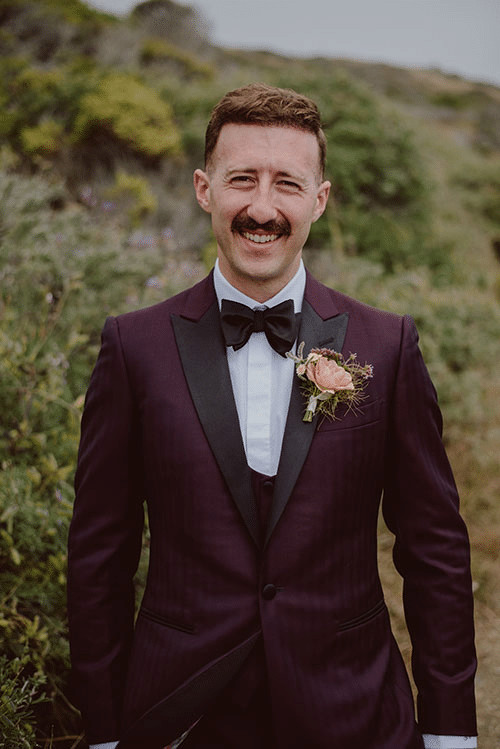Alopecia is a general clinical term that basically means hair loss. There are over 100 different types of alopecia that affect both men and women. Most forms of alopecia can be treated, but some forms cannot. Androgenic alopecia is by far the most common form of hair loss and is known as male and female pattern baldness.
Androgenic alopecia is mostly caused by age and hormones and there are many different treatment options for this common condition. Most of the causes of diffuse thinning hair are due to androgenic alopecia, and sometimes, diffuse thinning hair transplant surgery is the best option to fight against hair loss.
Diffuse Hair Thinning of Healthy Hair

Diffuse thinning is a term used to describe a general loss of hair throughout the entire scalp, instead of in concentrated areas, like the top of your head or along the hairline. This can sometimes give your entire head of hair a thin, see-through appearance.
A diffuse thinning hair transplant surgery will sometimes be a bit different than a standard procedure because more of an area of your head will need transplanted hair follicles, among other reasons we will get into later.
Being able to identify diffuse thinning will help you be able to come up with a solution quicker, be it hair loss medication or even a diffuse thinning hair transplant.
Frequently, diffuse thinning is the result of alopecia. However, it can also have other causes as well. Being able to identify those cases will be the first step in treating the condition.
Diffuse alopecia areata is challenging to treat. Even when treatment induces an increase in hair growth, hair loss may recur when treatment is stopped
They may also perform a hair pull test to see your hair’s strength and resilience.
The telogen phase is otherwise known to be the resting period of the hair follicle. When an individual is placed under circumstances of extreme stress, the hair is at heightened risk of entering the resting phase prematurely, leading to thinning and a noticeable loss of hair.
Diffuse Thinning Symptoms

Gradual Thinning
Diffuse thinning is characterized by a gradual reduction in hair density across the entire scalp. Unlike localized hair loss, this symptom manifests as even thinning, making it challenging to identify a specific affected area.
Increased Scalp Visibility
As diffuse thinning progresses, the scalp becomes more visible, especially when hair is wet or exposed to direct light. This heightened transparency is a notable indicator of thinning hair.
Reduced Hair Volume
Individuals with diffuse thinning may observe a decrease in hair volume, leading to an overall appearance of less dense hair. Despite a significant number of follicles, individual hairs become finer.
Increased Shedding
Experiencing an elevated amount of hair shedding during daily grooming activities is a common symptom of diffuse thinning. This includes increased hair fall during brushing, washing, or styling.
Weakened Hair Strands
Diffuse thinning often results in weakened hair strands that are more prone to breakage. Factors like hormonal imbalances or nutritional deficiencies can contribute to this increased fragility.
Changes in Hair Texture
Noticeable alterations in hair texture, such as increased frizziness or a finer, softer feel, are associated with diffuse thinning. These changes reflect the impact of thinning on individual hair strands.
Scalp Sensitivity or Irritation
Some individuals may experience scalp sensitivity or irritation as a symptom of diffuse thinning. This discomfort may be linked to environmental stressors or inflammation associated with thinning hair.
Diffuse Thinning and Its Causes

Diffuse thinning of the hair can just be how androgenic alopecia has just decided to manifest for you.
With no rhyme or reason, alopecia will cause many kinds of hair loss and not just the standard recession of the hairline or balding on the top of the head.
Diffuse thinning can slowly develop over the course of several months or it can appear quite suddenly. Being aware of how the hair loss is developing will help you identify diffuse thinning early.
The most apparent sign of diffuse thinning is of course reduced hair density and an easily visible scalp.
Generally, individuals with the thinnest hair will still be able to cover their head with hair so that the scalp is not seen. With diffuse thinning, the scalp will be visible for even people with normally thick hair.
The appearance of the scalp will be even more pronounced when the hair is wet or under bright, downward-facing light.
It is normal for us to lose right around 50 to 100 hairs per day. This shedding of hair is a part of our hair’s natural growth cycle.
For those suffering from diffuse thinning, you will start to lose hair much faster than normal on a daily basis. You will start to notice clumps of hair around your shower drain, in your hairbrush, and on your pillowcases and sheets.
Male Pattern Baldness & Treating Hair Loss

Male pattern hair loss is a very common form of hair loss experienced by a large percentage of the population. Many of these men experience diffuse hair loss and diffuse balding as they age.
This is due to the fact that many men have a genetic predisposition to diffuse balding as well as imbalances in hormone levels.
Often times, men experiencing diffuse hair loss have trouble experiencing new hair growth on a level that keeps up with their visible diffuse alopecia.
As hair regrowth slows down and hair health diminishes, noticeable hair loss becomes more prominent to the hair loss sufferer, as well as to those around them.
It is even possible for them to experience complete baldness over time, especially if they don’t address the cause of diffuse thinning early enough.
Female Pattern Hair Loss & Thinning Hair

Increased scalp hair shedding in middle-aged women is a completely common occurrence, although it happens much less than it does in men.
This form of hair thinning rarely results in a receding hairline as it does in male pattern hair loss, but the entire scalp may experience excessive hair shedding.
Additionally, as hair falls out and hair growth becomes less resilient over time, female pattern hair loss may show patchy areas.
Depending on the extent of diffuse balding in women, they may require medical treatments that increase blood flow, nourish the hair shaft, and encourage optimal hair growth as they age.
Telogen Effluvium & Diffuse Balding Hair Loss

Although there are many different possible causes of diffuse thinning, the most common culprit is telogen effluvium.
Telogen effluvium develops in your system when large amounts of your hairs enter the telogen, or resting, phase of the hair growth cycle.
Normally growing and healthy hair goes through a multi-phase growth cycle. In the anagen phase, the hair is growing healthily, and to its full potential over the course of around 2 to 6 years.
The next phase of the cycle is called the catagen phase, which is when the hair actively stops growing.
The last phase of the hair growth cycle is called the telogen phase. This is when the hair growth stops completely so that the hair is eventually replaced by strands of new, anagen hair, ready for growth.
What Form of Hair Loss Causes Diffuse Thinning?

A normal, healthy head of hair is in the anagen phase about 85 to 90 percent of the time, with the remaining hair in the telogen phase.
Telogen effluvium is when a large percentage of your hairs, normally around 70% of all the hairs that are supposed to be in the anagen phase, prematurely enter the telogen phase and begin falling out.
Most cases of telogen effluvium have to do with some kind of physiologic stress that has been put on the body, which can be brought on by a number of different reasons.
Severe fevers, infections, hormone changes, and traumatic events that bring on great deals of stress have all been known to cause telogen effluvium. (A, 1997).
Thyroid conditions and nutritional deficiencies have also been known to trigger telogen effluvium in the system. In rare cases, iron deficiencies and syphilis have been known causes.
How to Treat Diffuse Thinning

The best way to treat diffuse thinning is by identifying the root cause of the issue. If the cause is telogen effluvium, then you also need to further identify what is causing the stress on your system that is causing the telogen effluvium.
If you take the necessary steps to relieve that stress on your system, like changing certain medical conditions or treatment, adjusting your diet, reducing stress, or just recovering from an injury, then the issue will eventually clear up on its own.
As soon as the root cause of the diffuse thinning of the hair is addressed, you may want to look into a diffuse thinning hair transplant surgery.
If the hair loss is not severe enough to warrant surgery, then some topical hair loss drugs may help, like minoxidil and finasteride. Even a low-level light therapy hair restoration device, used along with the hair loss drugs may even be enough to restore the thickness of your hair.
Diffuse Thinning Hair Transplant Surgery Information

There are two main types of hair transplant surgery, an FUE, and a FUT procedure. During a FUT hair transplant, your surgeon harvests a thin strip of hair-bearing tissue from a selected donor area.
Then they dissect the individual hair follicles for transplantation. An FUE procedure is when just the individual hair follicles are extracted for transplant, instead of strips of tissue.
There are types of diffuse thinning hair where just the crown of the head is affected or other specific areas of the scalp.
In these situations, a FUE hair transplant would be effective as a treatment option for diffuse balding.
This is because the doctor would be able to strongly identify a donor area that is not affected by the diffuse thinning. That ensures the transplanted hair follicles grow strong after the transplant.
However, if the entire scalp is affected by the condition, then the surgeon would have difficulty deciding which hair follicles should be used as donor hair.
Is Telogen Effluvium Causing You Problems with Hair Fallout?

If the transplanted follicles were affected by telogen effluvium, then transplanting them to a different area of the scalp would do little to help them to enter the regrowth phase.
In fact, the transplant would put undue stress on the already unhealthy hair follicles. Chances are it would die shortly after the procedure.
If you get a FUT hair transplant, it would be difficult for the surgeon to ensure that the entire strip of donor hair is not affected by the telogen effluvium.
This is not to say that a diffuse thinning hair transplant surgery would not be effective. A skilled hair transplant surgeon can detect which follicles are healthy and which may be affected by diffuse thinning hair.
Finding a skilled hair transplant specialist is vital to the success of a diffuse thinning hair transplant surgery.
Best Hair LA is Your Diffuse Hair Loss Specialist

Here at Best Hair LA, we make all forms of hair restoration our business. Our doctors and surgeons are well-versed in what causes diffuse hair loss and all other forms of alopecia.
We have treated diffuse hair thinning and diffuse balding with both surgical and non-surgical hair loss solutions. If you need hair transplant surgery, we’ll identify which method will be best for you. We will provide the results that you hope for.
Diffuse hair loss is one of the hardest hair loss conditions to treat. You need a specialist on your side that will take the time to understand your condition.
One that will offer the solution that is best for you. A lot of other hair clinics will just throw you on the operating table, hoping to make a quick buck.
Our hair loss specialist will sit down with you and discuss your hair restoration needs in detail. The only thing you have to lose is more hair, so call us today.
Diffuse Thinning Hair Transplant Surgery in Los Angeles

Best Hair Transplant is the best place to schedule your diffuse thinning hair transplant in Los Angeles. We’ve helped both men and women regrow hair lost to diffuse hair thinning. But don’t take our word for it. We suggest learning as much as possible about hair restoration. Do so prior to making a decision on how to address your hair loss. Not every procedure is right for everyone.
Best Hair Transplant
1970 S. Prospect Ave., Suite 2 Redondo Beach, CA 90277
(213) 403-0455
References:
A, R. (1997). Telogen Effluvium. Karger Dermatology.
